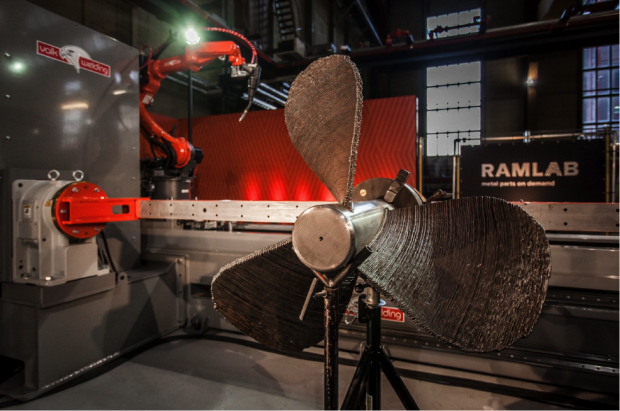Future of Making Things

A ship’s propeller created for the project using the new ‘hybrid manufacturing’ technique.
Latest News
September 1, 2017
The Port of Rotterdam’s Additive Manufacturing Fieldlab (RAMLAB) and Autodesk have revealed the first pilot component as they pioneer the use of additive manufacturing in the maritime industry. A ship’s propeller was made using a hybrid manufacturing process combining wire and arc additive manufacturing using industrial robotic arms and subtractive machining and grinding techniques.
As the largest port in Europe, the Netherlands’ Port of Rotterdam is one of the most important intersections for the flow of cargo in the world. It offers the region’s best connections to global ports and handles over 460 million tons of cargo a year, so it’s imperative that the facility and ships run smoothly.
Currently, if a vessel comes into port needing a replacement part—a propeller, for example— it can take weeks or months to order and deliver, costing companies millions of dollars while they wait. It can also be quite costly for companies to keep large stockpiles of parts in warehouses around the globe.
 Port of Rotterdam. Image courtesy of Freek van Arkel.
Port of Rotterdam. Image courtesy of Freek van Arkel.To tackle this challenge, the Port opened the innovative RAMLAB, an onsite facility which includes a pair of 6-axis robotic arms capable of additively manufacturing large metal industrial parts. The team at RAMLAB works with a dedicated network of hardware and software partners, academic and certification institutions and key end users to help the Port stay on course to become the smartest port in the world.
As a main software partner, Autodesk has played a key role in developing RAMLAB’s innovative hybrid manufacturing approach, which entails combining additive and subtractive manufacturing. This style enables RAMLAB to pursue faster fabrication options: 3D printing large ship components in metal and then finishing the pieces using traditional CNC milling and grinding methods within a matter of days, saving time and money without sacrificing precision or performance.
 A ship’s propeller created for the project using the new ‘hybrid manufacturing’ technique.
A ship’s propeller created for the project using the new ‘hybrid manufacturing’ technique.“The Port of Rotterdam’s RAMLAB initiative is a great example of how whole industries are being disrupted by industrial additive manufacturing,” explains Steve Hobbs, VP of CAM and Hybrid Manufacturing at Autodesk. “Creating an ‘on-demand’ hybrid manufacturing capability for replacement parts will have a major impact on reducing wasted time and cost currently incurred across the maritime industry when ship parts are damaged. We’re excited to be working alongside some of the key players in the marine industry to bring to reality this very tangible example of the future of making things.”
“With the work being done at RAMLAB, the group hopes to accelerate the cross-industry adoption of hybrid manufacturing for making large-scale parts on-demand,” says Vincent Wegener, Managing Director of the RAMLAB. “Our aim is to make the Port of Rotterdam not just an important gateway for Europe, but also a leader in the development of new manufacturing methods. Autodesk is a key partner for us due to its expertise in how to design and manufacture using both the latest additive manufacturing techniques and more traditional CNC and machining methods.”
The ship propeller pilot project was created in close collaboration with Autodesk and the next step will be for a final, to scale, version to be manufactured and fitted to one of the partner’s ships in the summer of 2017.
In addition to the work done onsite at RAMLAB, Autodesk has also assisted RAMLAB by providing access to its Advanced Manufacturing Facility (AMF) in Birmingham so that new design and manufacturing concepts could be explored. Collaborative activities by the two organizations include
- exploring the design of components and investigating design features made possible by additive manufacturing;
- preparing these components for manufacture by creating appropriate preforms with the essential considerations;
- building these components considering the distortion and stress on macroscale geometric fidelity and thermal management; and
- postprocessing techniques to bring these components to final form in a repeatable and reliable manner.
“We’re bringing additive manufacturing to a truly industrial scale. So much 3D printing to date has been limited to smaller components. But the technology – both software and hardware – is now ready for bigger things, and we’re seizing that opportunity to show the world what’s possible.”
About RAMLAB (Rotterdam Additive Manufacturing Lab) makes the vision of manufacturing certified large metal parts on demand through Additive Manufacturing a reality. For more information visit ramlab.com or follow @RAMLABNL.
Subscribe to our FREE magazine, FREE email newsletters or both!
Latest News






